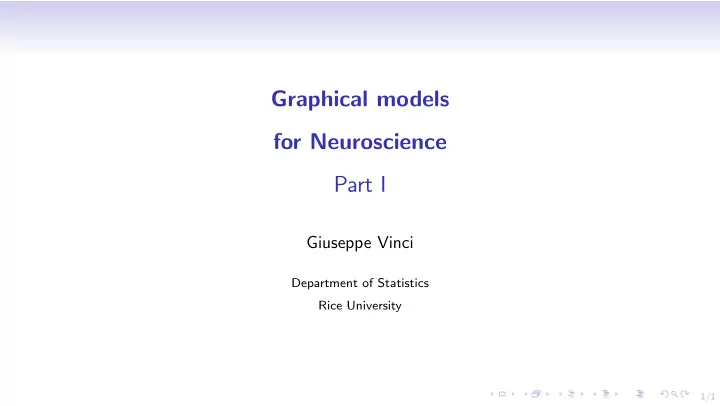

Graphical models for Neuroscience Part I Giuseppe Vinci Department of Statistics Rice University 1/1
Outline 1. Neural connectivity 2. Graphical models 3. Gaussian Graphical models 4. Functional connectivity in Macaque V4 2/1
Neural connectivity How does the brain work? Through concerted ac- tions of many connected neurons. We need to know these connections to: • Understand causes of brain disorders. E.g. Parkinson, Alzheimer. • Interface prosthetic devices. 3/1
Neural connectivity Two different perspectives • structural connectivity = physical connections • functional connectivity = neurons activity dependence → Understanding brain functions under differing experimental conditions. → It needs to be inferred from ( in vivo ) experimental data recordings, i.e. we need to see how neurons behave. 4/1
Functional Connectivity = neurons activity dependence Dependence between brain areas ( macroscopic scale ) fMRI, EEG, ECOG, LFP 5/1
Functional Connectivity = neurons activity dependence Dependence between neurons ( microscopic scale ) video link 6/1
Dependence • Let X = ( X 1 , ..., X d ) ∼ P be neural signals • How could we describe the dependence structure of X ? • Analytically • Contour density plots, spectral analysis • Graphs 7/1
Dependence Graph Graph G = { N , E } where N = { 1 , ..., d } = nodes and E = [ E ij ] = edges with E ij ∈ { 0 , 1 } . 8/1
Markov Random Field • A random vector X forms a Markov Random Field with respect to a graph G if it satisfies the Markov properties 1. Pairwise: no edge ⇔ indep. conditionally on all other variables 2. Local: indep. conditionally on neighbors 3. Global: indep. conditionally on separators 9/1
Gaussian Graphical Model • A Gaussian Graphical model is a Markov Random Field • The p.d.f. of X ∼ N (0 , Θ − 1 ), with Θ = [ θ ij ] ≻ 0, is � � (2 π ) − d / 2 √ − 1 2 x ′ Θ x p Θ ( x ) = det Θ exp d � 1 = exp − 2 θ ij x i x j + const . i , j =1 • θ ij = 0 ⇔ no edge between X i , X j ⇔ cond. independence θ ij √ • Note that partial correlation ρ ij = − θ ii θ jj ∈ [ − 1 , 1] is a more interpretable measure of conditional dependence. 10/1
Gaussian Graphical Model 11/1
GGM - Estimation • We need to estimate Θ. • Suppose we collect data vectors Data = { X 1 , ..., X n } from n repeat experiments. • To estimate Θ, we start by defining the likelihood function n � p Θ ( X r ) L (Θ; Data ) = r =1 12/1
GGM - MLE � Θ MLE = arg max L (Θ; Data ) Θ ≻ 0 • Simple but can have undesirable statistical properties because: � d � = d ( d +1) • Major problem: number of parameters in Θ is d + and sample size may 2 2 be small in some applications. E.g. d = 100 ⇒ 5050 parameters and n = 200 • Minor problem: � Θ MLE does not give exact zeros. 13/1
GGM - Penalized MLE • Penalized MLE � Θ( λ ) = arg max log L (Θ; Data ) − P λ (Θ) Θ ≻ 0 where P λ ≥ 0, and λ is chosen in some way (CV, BIC, Stability). E.g. P λ (Θ) = λ � Θ � q q (usually excluding diagonal elements) • q = 0 penalizes number of edges. • q = 1 is the graphical lasso 1 . • q = 2 is the ridge regularization. 1Yuan and Lin (2007), Friedman et al.(2008), Rothman et al.(2008), Fan et al.(2009), Ravikumar et al.(2011), Mazumder and Hastie (2012), Hsieh et al.(2014). 14/1
GGM - Bayesian regularization • Penalized MLE can be seen as the maximum of the posterior distribution π (Θ | Data ) ∝ L (Θ; Data ) × π (Θ | λ ) � �� � � �� � likelihood prior where π (Θ | λ ) ∝ e − P λ (Θ) I (Θ ≻ 0). • Note that we can also compute posterior means instead of max. • The parameter λ can be selected by imposing a hyper prior π ( λ ). 15/1
What if data is not Gaussian? • Transform the data: e.g. √ spike-count can be approximately Gaussian • Hierarchical model: Y ∼ P X , and X ∼ N (0 , Θ − 1 ). • Use another graphical model: e.g. Poisson graphs 16/1
Example: macaque V4 (Vinci et al. 2018) square-root transformed spike-count (500ms) of d = 100 neurons, n = 126 for each 17/1 condition.
Recommend
More recommend